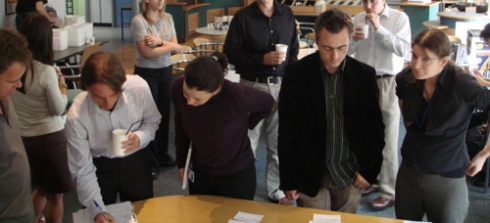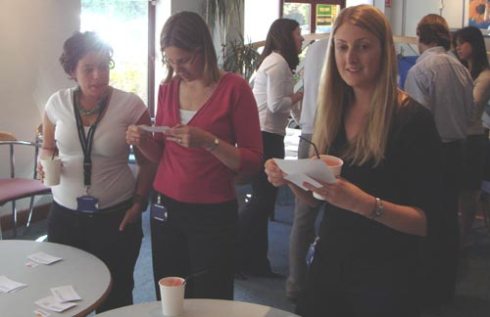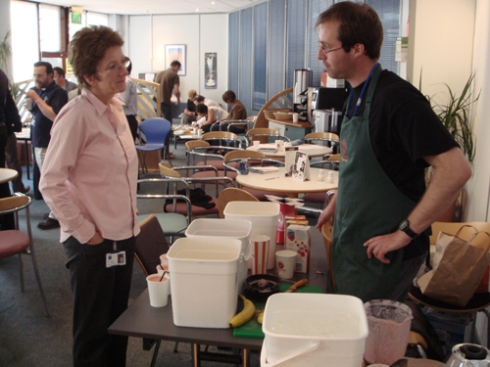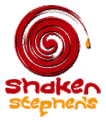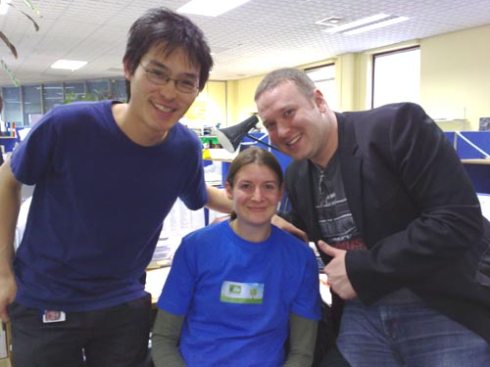You are currently browsing the monthly archive for May 2007.
It’s nearly time to check in and let you all know where we are in development. But first I thought I’d tackle the thorny issue of a release date and why you can’t rush great art.
The most natural (and usually first) question anyone asks when they hear about ode is: “when’s it coming out then?”
Part of me wants to loudly exclaim that I bet you wouldn’t ask Leonardo Da Vinci when that portrait of the lady with the weird smile is going to be finished. Or that you wouldn’t dare say to Michelangelo as he worked on the Sistine Chapel: “Ottenga un movimento sopra. State lavorando a questo per 4 anni. Avete detto che sareste rifiniti entro la fine settimana.” He was a bit of a misanthrope by all accounts and would likely have chased you through Rome, cursing your impudence.
But, of course, I don’t. Someone is waiting on a return that justifies their investment. It’s no good telling exclaiming “oh, it’ll be out eventually”. You might aswell open their wallet, take out a twenty and light a big cigar with it.
But it needs to be balanced. I strongly believe software design is an art form. It takes love, dedication, artistic tantrums and lots of rubbing out. This is why it sends a shiver up our spines when we are asked which day it will be…grrr…”finished“.
You create something that, if it works, will touch the user in such a way that it hopefully transcends practicality and brings about an emotional connection. Whether you like it or not Myspace’s 100 million users feel an artistic connection to their “space” and how it represents them as part of the greater whole. That’s art to me (even if you couldn’t fit it in a gallery).
The vast majority of 37 Signals’ userbase would consider their unique understanding of their audience has been elevated to an artform. It’s not technology as a mechanical process.
The ipod will be remembered as a perfect peice of design for a long time to come.
Ask any videogame fan to name their best moment in their favourite game and you will see their eyes mist over with an ecstasy comparable with opera fans describing their favourite aria or how an architect might feel when confronted by Sagrada Familia. Is it too much to compare those emotions to the first time you experience Google Earth? I don’t think so.
Now we cannot presume to stand in such august company but creating an original web app is akin to creating art. You start with a big idea (“We want to sell little bits of digital content to educators”) that is like a big block of marble. You can see a beautiful finished product in your minds eye but there’s a lot of marble to chip away to get to it.
Everytime we code a new function or add some new content or make a breakthrough on an idea or receive a brilliant bit of user feedback it chips away a little more, thus making the final shape more distinct.
This analogy runs out of steam at a very specific point: eventually a sculptor will lay down the hammer and chisel and step back to admire thier work. It is done.
For good or ill software is never finished, only improved upon.
But we are the best judges of who to release it to and when (how often?) that should happen.
With software you can always improve and adjust the shape of your application. You must always want to continuously fine tune. So we will release to privately invited beta users at different stages. Then we will open our doors wider to let in more users and so on. We have loads of ideas of what we want to do with ode but they won’t necessarily be there when you use ode for the first time.
As the saying goes: release early and often. ode won’t be “out” and complete on a certain day. It will be out all the time in new and improved ways.
Now go and read the Black Perl.
Any digital asset can be tagged. A tag is simply a keyword that can be attached to an article or object that can be usefully employed as a search or reference term.
All the content served through ode will have a set of tags against it. These may be curriculum based (year 7, Key Stage 3, rock types: weathering processes) or keyword based (snow, cold, rocky, dark, eagles, flying).
But the on demand teaching that ode will enable will also acknowledge the fact that we can take it one step further. This is where deep tagging can be used. It will require a human being doing the tagging but it’s an extremely worthwhile process.
“…I like the idea of deep tagging. It requires human labor but for many publishers it’s worth it. Instead of simply being associated with a file, a deep tag is associated with a clip from the file. Click on the tag and jump right to that part of the clip.”
http://www.techcrunch.com/2006/10/01/all-the-cool-kids-are-deep-tagging/
Let me give you an example. Mrs Jones is a KS3/4 history teacher. She’s about to welcome a busy classroom of eager students and has a set of objectives around “USA: equality & civil rights after 1900: Martin Luther King” that she would like to get through.
She has pre-bought a video from ode and it’s sat waiting to be played in her content library. It’s a 40 minute documentary about the life of Martin Luther King. Ordinarily this would be too long and would dominate the lesson. Up until now she’s had to fast forward an old VHS tape that’s been in the school for 10 years. She knows her students would enjoy the visual and audio presentation (reading his famous speech cannot compare to hearing it).
But it’s a frustrating way of delivering it – trying to search through a video cassette or spending the evening before painstakingly going through it to find the good stuff.
It is tagged “America, 20th Century History, speech, dream, Martin Luther King, assassination”. This will help her find it in her library (it certainly helped her find it when shopping in ode) but what it doesn’t do, and where deep tagging could really benefit any educational experience, is show where the documentary exactly delivers the learning.
For example it could be deep tagged like this:
- Credits 00:00:01
- Introduction to the civil rights movement 00:00:38
- Footage of Malcolm X reacting to the “March on Washington for Jobs and Freedom” in 1963 00:10:23
- Interview with Coretta Scott King 00:12:02
- The “I have a dream speech” at the Lincoln Memorial 00:15:30
- “Let Freedom ring!” to end of speech 00:29:00
- News report on his assassination in Memphis, Tennessee on April 4th, 1968 00:31:58
- The impact of the civil rights movement on America 00:36:12
By flagging these important sections in the documentary Mrs Jones can click and jump directly to the sections that she feels are the most important parts for her students to see. She can even jump to the rousing end of the speech, the bit that really makes you tingle when you hear it. She can create impact, she can save time, she can instantly work the media to her advantage.
And if she finds another section she feels is worth bookmarking but hasn’t yet been deep tagged by us or by the community she will be able to allocate her own personalised deep tagging.
She is in control of the digital content. Free at last, eh?
“Let freedom ring. And when this happens, and when we allow freedom ring—when we let it ring from every village and every hamlet, from every state and every city, we will be able to speed up that day when all of God’s children—black men and white men, Jews and Gentiles, Protestants and Catholics—will be able to join hands and sing in the words of the old Negro spiritual: “Free at last! Free at last! Thank God Almighty, we are free at last!”
Martin Luther King Jr, 1929-1968

Well, the big experiment has come and gone and was a massive success. The experiment went a little bit like this…
1) We let people know at the door that they were at the right place. This was important.
2) The majority of those invited were Publishers and Editors, but we also sprinkled in a mixture of people from other professions, following the 1st rule of forming an intelligent crowd:
i) It needs to be diverse, so that people are bringing different pieces of information to the table.
ii) It needs to be decentralized, so that no one at the top is dictating the crowd’s answer.
iii) It needs a way of summarizing people’s opinions into one collective verdict.
iv) The people in the crowd need to be independent, so that they pay attention mostly to their own information, and not worrying about what everyone around them thinks.
Firstly we asked people to fill out a questionnaire whilst they waited for a slot on the experiment. It contained the usual stuff we want to know peoples’ opinions on such as VLEs, SCORM, tagging etc and the old chestnut “Anything else you’d like to add?” (mainly due to having a big blank space at the end and running out of proper grown up questions to ask).
We’ll send out the results to the participants very soon but a sample Q&A is below:
Q: Please let us know any thoughts you have about VLEs (Virtual Learning Environments) and the use of disaggregated electronic resources (little bits of learning) in schools/colleges:”
- “Good idea – reduces the startup time using new content and means new content doesn’t need to carry around duplicated authorisation stuff.”
- “Seems to ‘fit’ with where most are going and puts the teacher in the ‘driving seat’. I think primary schools are probably still a bit unsure about VLEs themselves but would be positive about the concept as long as there’s no techie things to worry about! As well as bits of content, they still may want a suggested programme or guide for how to link things together and to define where they fit in the curriculum.”
- “Not to be ignored, although I’m unsure how much they are used by teachers at the moment. As things progress SCORMed content will be more and more central to learning.”
- “In colleges Moodle is used and becoming default. Tutors put little bits of their own prepared material onto it. Also bits they found elsewhere and found useful e.g. Construction animations of water being pumped through a boiler; an engine working. It is still very variable in depth. Quality is not an issue.”
- “Think they’re used a lot but not effectively. Teachers waste loads of time surfing for free content and find it doesn’t meet their needs.”
3) We then invited people up in pairs. They were given a brief introduction to what we were trying to do and then told to work individually not collaboratively. The proposal we put to them was: “In your judgement what sort of content would go under what sort of category in ode?” This was to help us decide our content taxonomy and the whole reason for this experiment.
4) We placed 12 categories on the table that, in the teams’ judgement, filled every permutation for the ode content taxonomy. A good taxonomy would provide the users with quick, painless search. A complex or misjudged taxonomy would impede the users progress through ode, thus creating a frustrating and limited experience.
5) We then gave each participant a stack of content examples and asked them to place each one under the category they felt suited it best. There were no right or wrong answers.
For example would a “10 x spelling activities (Macromedia Flash + accompanying MP3 files)” come under “Pupil Activity”, “Tool”, “Teacher Support” or “Assessment”? There was also the all important “Don’t know” category, which we could then dig deeper into and draw out some further thinking on why that content was difficult to place.
Whilst doing all this everyone who volunteered to come along was given a top quality freshly made-on-the-spot smoothie from our friends down at “Shaken Stephens” (below is the titular Stephen who heroically offered to serve the smoothies himself, in case you thought maybe we meant this one although it would have been awesome if we had). And an ode branded cupcake from Caketoppers, who will put anything on a cake that takes your fancy, within reason.
So did the Wisdom of Crowds method work? Well we’ll know more when we have analysed the data properly but first impression is a resounding yes. We appear to have reached, through everyone’s input, as definitive content selling taxonomy as we’re going to get. And the nice thing about asking everyone else to decide for you is that you can blame the stupidity of mob rule if it doesn’t work!
I’m joking of course. See you at the next one?
PS: Sian Smith won the T-Shirt and it fitted perfectly. The two grinning idiots either side of you were an unfortunate by product of presenting the prize but I’m sure it was worth it…
“If a picture is worth a thousand words, then Google Image Search is now worth 1 trillion, 187 billion, 63 million words. Yes, that’s right, math majors; we’ve updated our image index, and now offer users precisely 1.18763 billion newly updated images….
In my previous blogpost “Who’s Counting” I put forward the case that beyond a certain threshold numbers are pretty useless in describing value. I would like to add a caveat: except when it comes to marketing when bigger = better.
It seems that internet marketing and ROI is all based around seriously massive figures that are so high as to become abstract. That’s a natural consequence of operating on a global scale but our relationship with any website is by definition always 1-to-1, so to me it all seems a bit hard to comprehend. After all, imagining millions of unique visitors is not the same as actually seeing them all from space.
Kumbh Mela gathering (Photo: spaceimaging.com)
So, just for fun, I racked my brain to think of a way to get to a ludicrous number for ode. And then it hit me – everyone mentions time saving as a potentially massive benefit. So how much time could ode save every UK teacher?
Our teacher users, so far, reckon they spend on average 3 hours per week sourcing digital content across the internet from Google, Blogs, Flickr, resource banks, home brew websites, online subscriptions and so on. Sometimes this is at home, but mostly at work. And they all resent it to some degree as, frankly, it’s a drag.
3 hours per week per teacher (some spend up to 10 hours per week!). That’s 12 hours per month spent looking for content. Or 144 hours per year. On average, give or take.
There are roughly 500,000 teachers employed in the UK, across Primary, Secondary and College/FE sectors.
144 x 500,000 = 72,000,000 hours in total spent by teachers every year trawling a variety of sources for digital content to plug into their lessons. And time = money as we all know.
If the average teacher salary for a classroom teacher who’s been in post for 3 years is £25,000 per annum (very rough estimate) then this works out at about £14.29 per hour.
So therefore…72,000,000 hrs x £14.29 = £1,028,880,000 of teacher’s time on this common task.
If ode, as a one stop shop for all your educational digital content needs halves that time (and we think we can do even better than that) and then we reduce that figure even more to say that 50% of that time is unpaid working from home time and shouldn’t be included so we halve it again we’re left with £257,220,000. Deduct that from the original total annual cost and ode could save the government £771,660,000 per year.
How’s that for a stupid meaningless figure?


